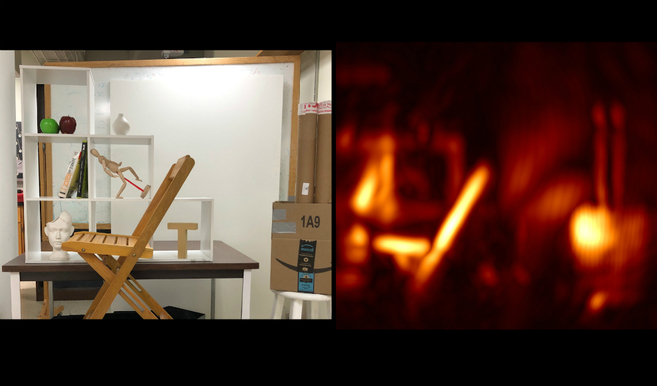- Profile.Diego Gutiérrez, the Spanish genius that NASA pursues
- Technology: The startup from Zaragoza that detects if your baby does not see well
Light allows us to see what is in front of us. A group of scientists proposes to use it, in addition, to reveal what is hidden . Researchers from the universities of Zaragoza and Wisconsin-Madison have shown that it is possible to reconstruct complex scenes that develop outside the line of sight using a virtual camera, capable of visualizing what is on the other side of an obstacle.
Details are described this Monday in the journal Nature .
The key is the use of light particles, projected indirectly on the hidden scene by laser pulses that bounce off the surfaces, similar to the echo in the acoustic waves . 30 picoseconds after each drive, special sensors capture those photons back. "Each wall then becomes a virtual photo camera," says Diego Gutierrez, a professor at the University of Zaragoza and a member of the Engineering Research Institute of Aragon. The analysis of these bounced particles provides the information necessary to digitally reconstruct the hidden scene in three dimensions.
Although in the last decade different laboratories have developed several methods to obtain images outside the line of sight, technical complexity has limited the results to blurred images of simple scenes. However, this new approach allows us to overcome these limitations and capture images of much more complex hidden scenes, even in real conditions, outside of laboratory tests. "We realized that, if a camera can capture an image regardless of the complexity of the scene, the same principle should be applicable to our work," Gutierrez explains.
While other approaches had been based on the intensity of the reflected light to extract information, in this case the authors have worked based on the behavior of the light wave . "Expressing the light as a wave we found a lot of valuable information that we were not using until now," says the researcher.
See through several corners
In this way the reconstruction of the hidden scene is carried out through wave diffraction , applying physical principles known for more than 150 years - such as the Fourier optical call - and which were already being implemented by almost all systems Image capture to interpret the waves and rebuild the scene. "Our systems have the same underlying mathematics as before, but they achieve a surprisingly accurate reconstruction, even using really bad data," adds Andreas Velten, professor of biostatistics and medical informatics at the American University of Wisconsin-Madison.
With this new approach, scientists have created a method that allows visualization in real conditions , regardless of differences in wall materials, ambient light scattering or different depths of field. In addition, that ability to project a camera from one surface to another suggests that technology has the potential to see around multiple corners. "For this, light has to go through multiple reflections," explains Velten, "the problem was how to separate the light that comes from different surfaces. But this 'virtual camera' can do it."
Interest of the US government
The article is based on a research carried out in 2013 by MIT scientists - in which Velten and Gutiérrez already collaborated - that developed a mechanism capable of capturing a billion frames per second, thanks to a laser with a frequency of one femtosecond. "This work in Nature is a bit the culmination of the path started then," says the Spanish researcher.
Precisely the promising results of investigations such as that led the US Department of Defense to be interested in the potential of this technology . Thus was born the REVEAL program for the Revolutionary Increase of Visibility through the Exploitation of the Active Fields of Light, with an endowment of 27 million dollars. "It is a curious process, in which several laboratories that work in different teams are selected and in each phase they are eliminating those that they consider less promising," Gutierrez explains. "Seeing great universities like Princeton fall while the University of Zaragoza and its team were moving forward is a source of pride."
Possible applications
The authors believe that this work also creates the conditions to develop a more economical and compact technology, which approaches its application in the real world. The potential in this field ranges from military applications or spy services to autonomous car navigation, through images to assist surgeons or search and rescue missions. NASA follows with special interest its development, seeing this technology as a way to explore the caves of the Moon.
In any case, the researchers point out that the technology still has room for improvement , for example if sensor sets could be designed to capture the light reflected at various points. The experiments described in the article have used a single sensor. "Technology comes a little on the back of Science," explains Gutierrez. "We have created the conditions that allow this technique to be taken out of the laboratory, but for now we still need pulses of light that are still complex and expensive."
According to the criteria of The Trust Project
Know more- Science and Health
Climate change Madrid will be as hot as Marrakech in 2050
Health European justice confirms that bisphenol A is toxic for reproduction
Artificial intelligenceThe machines already know how to mark a lantern and win poker

